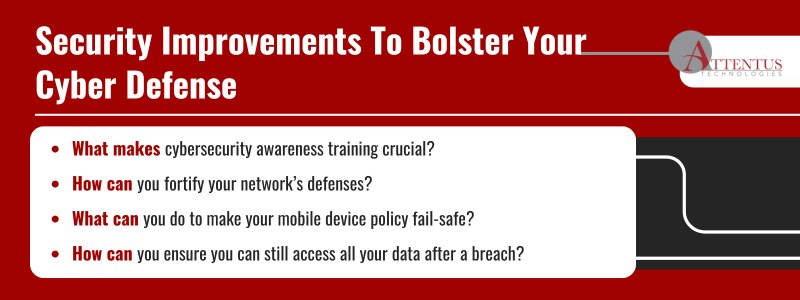These 4 security improvements will bolster your cyber defenses keeping you ahead of the criminals.

Entrepreneurs and business owners take note: Q2 2024 saw a 30% year-over-year increase in cyber attacks. IBM says that a data breach now costs $4.88 million on average. Can you afford to leave your business exposed? The answer is clear—security must be a top priority. Here are four essential security improvements to start implementing today:
# 1. Are Your Employees Prepared to Defend Against Cyber Threats?
Your team is your first line of defense, but without a security-first mindset, they can also be your weakest link.
Here’s why cybersecurity awareness is critical:
A 2023 Kaspersky report on the correlation between the human factor and cybersecurity reveals that policy violations and inappropriate I.T. resource use by employees are two of the greatest threats companies face. Here are some crucial stats from the report:
- 26%—cyber incidents resulting from information security policy violations.
- 38%—breaches resulting from genuine human error and inappropriate I.T. resource use.
Human-caused security incidents often stem from a lack of awareness about threat actors’ tactics (e.g., phishing and social engineering) and security best practices (e.g., what constitutes solid passwords and what to do if they suspect a breach has occurred). However, they can also result from employees using third-party tools to bypass efficient tools and processes—a phenomenon known as shadow I.T.
So, doubling down on security efforts on these fronts is crucial to ensuring that bad guys cannot penetrate your first line of defense.
- Communicate your security policy and procedures while explaining employees’ role in safeguarding sensitive data and complying with handling and confidentiality laws. This includes, for example, creating awareness about how using Shadow I.T. limits the visibility of the company threat landscape, creating potential back doors hackers could exploit.
- Host mandatory training sessions at least twice yearly to update employees on cybersecurity threats to your company. Cover the basics of safe online practices and how to recognize the latest phishing and social engineering tactics so they don’t fall prey to malicious actors.
- Implement regular simulations of potential (internal and external) threats to test your team’s cybersecurity readiness.
Remember to foster an environment where employees feel comfortable reporting suspicious activities and asking any questions they might have regarding security.
# 2. Is Your Network Secure Enough to Withstand an Attack?
Your network should be the next item on your security improvements checklist, as it’s the highway through which all your data and business operations pass.
Best practices to protect your company’s network include:
- Conducting regular audits to identify and address vulnerabilities, unused applications, open ports, and security gaps.
- Segmenting your network into small, isolated sections so that if one area is compromised, the others remain safe.
- Deploying firewalls and intrusion detection systems to control and monitor incoming and outgoing network traffic and catch suspicious behavior in real time.
- Limiting network access based on users’ roles and the least privilege principle while incorporating multi-factor authentication (MFA) as an extra protection layer.
Ultimately, your network architecture should have Zero Trust baked in. It should “never trust and always verify,” meaning that every access request must be authenticated and authorized, regardless of whether it originates inside or outside your network perimeter.
# 3. Are Your Mobile Devices a Gateway for Cyber Threats?
The rise of remote work and “Bring Your Own Device” (BYOD) policies has opened new doors for productivity—and new windows for cyber threats. How do you balance convenience with security?
A strong mobile device policy should include:
- Device registration to track who accesses your network and with which device.
- Security requirements such as strong passwords, biometric authentication, and encryption.
- Application management with a list of approved apps (whitelisting) and blocked apps (blacklisting).
- Clear employee guidelines on reporting lost devices and handling sensitive data on personal devices.
Finally, schedule periodic reviews of your mobile device policy to adapt to new threats, technological changes, and shifts in organizational needs. Continuous improvement is critical to maintaining robust security.
# 4. Do You Have a Reliable Backup Plan in Case of a Breach?
Imagine losing all your business data overnight. Could your business recover?
About 94% of companies that get breached never recover their data; the other 6% can take over 150 days to regain complete control of their data. That’s why a solid backup plan is so crucial. It’s like an insurance policy—you hope you’ll never need it, but it’s indispensable when disaster strikes.
Strengthen your backup policy with these steps:
- Determine the scope of your data and what needs the most protection.
- Conduct a business impact analysis to assess potential risks associated with a data loss event and determine recovery priorities.
- Decide how often backups should occur based on the data’s importance and your recovery point objectives.
- Choose the most suitable backup strategy for your business:
- Full backup saves complete copies of all data every time.
- Incremental backup saves changes made since the last backup.
- Differential backup saves modifications since the previous full backup.
- When implementing backup solutions, follow the 3-2-1 rule to diversify risk:
- Keep three copies of your data on two different storage types, with one copy off-site.
- Finally, regularly test your backup systems to ensure they work as they should.
With a robust backup policy, you’ll be assured of business continuity no matter what comes next.
Let Attentus Help You With Security Improvements
One thing is constant in technology—change. As threats evolve, so must your approach to security. Take a moment to reflect on your current defenses. What are its biggest challenges? Now, imagine the benefits of implementing the security improvements we’ve discussed. Wouldn’t it help you sleep better knowing you won’t wake up to put out fires? Attentus Technologies can help make that possible.
Attentus Technologies has been in the I.T. space for 21 years and counting. Over the years, we’ve learned that there’s always room for improvement. That’s why we evaluate our performance constantly to see what we can do better. In fact, seeking constant improvement is one of our core values. While perfection is elusive, seeking constant improvement places us and our clients closer to achieving it. And that’s what’s most important.
We’d like to extend our security expertise and experience with continuous improvement to help you keep bad actors out completely. Contact us now to forge a security alliance that covers all bases.

